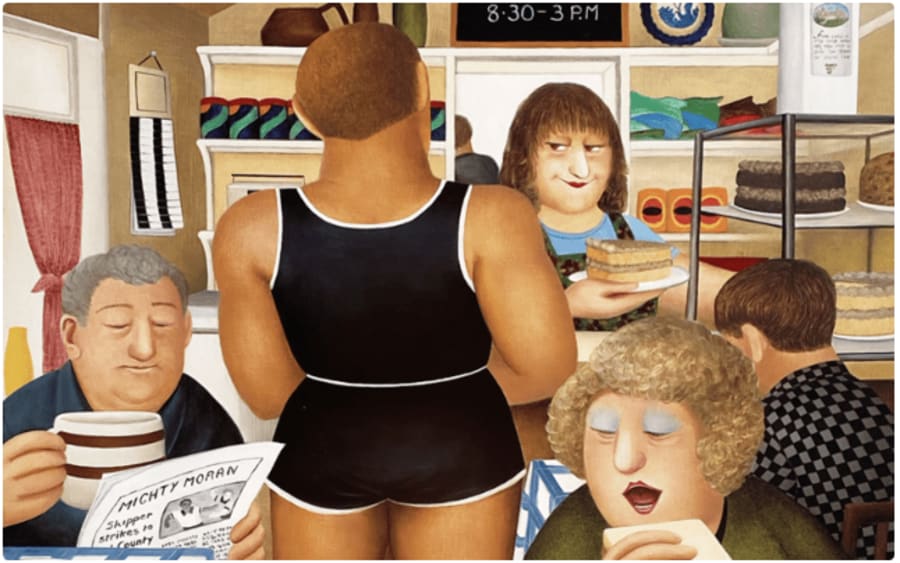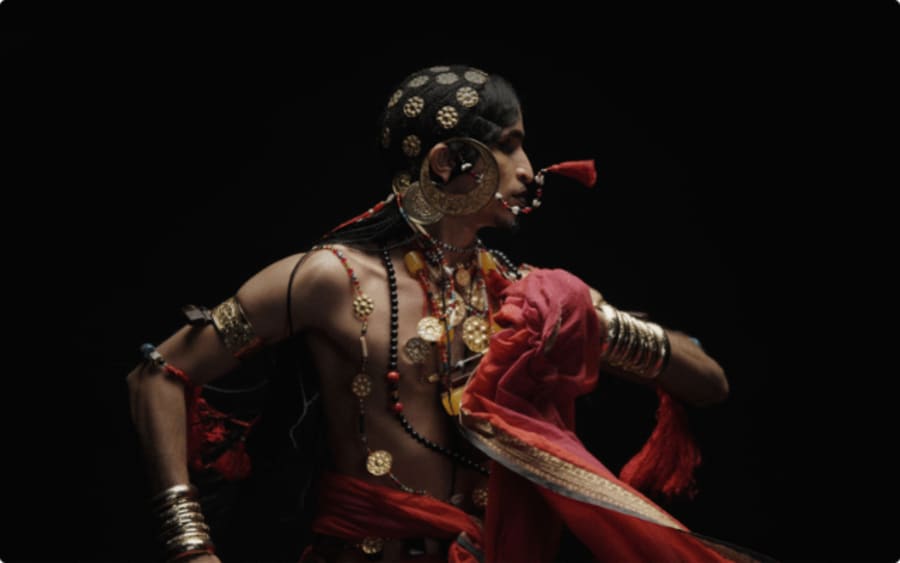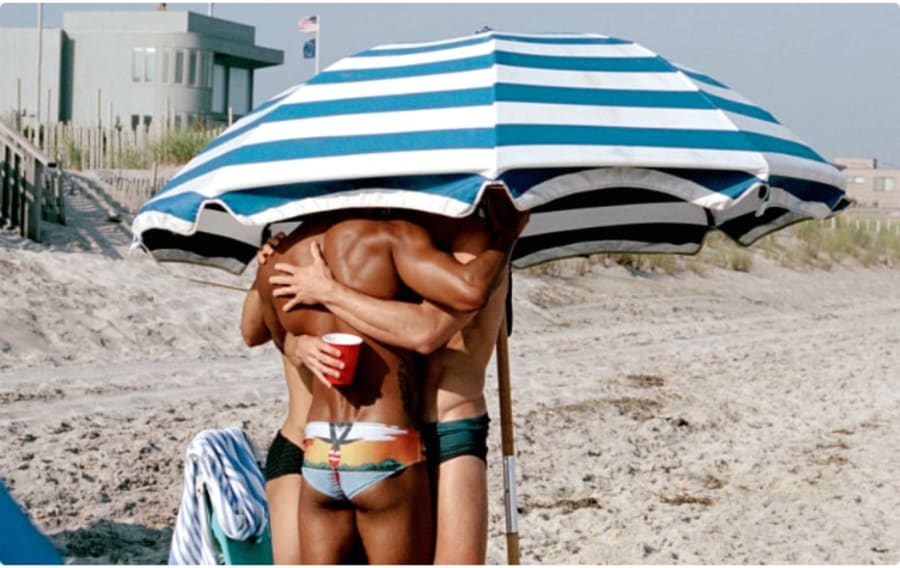In a striking portrait photograph, the artist Zanele Muholi looks directly at the viewer, their face radiant and framed by dozens of clothespins jutting from their hair in every direction. Their lips are overdrawn in white, so that they stand out against the rich darkness of their skin, a difference Muholi emphasizes by upping the contrast in the image. This picture, Bester I, Mayotte (2015), is one of the many self-portraits that make up the South African photographer’s series ‘Somnyama Ngonyama’ (2012-ongoing), selections from which are currently on view in Muholi’s expansive retrospective at the Tate Modern in London. In other shots, a vacuum cleaner becomes an elegant head wrap, latex gloves are fashioned into a robe – everyday objects that, in Muholi’s hands, are loaded with much deeper cultural and political meanings.
The clothespins are an homage to Muholi’s mother, who worked as a domestic. Before they began photographing themself in 2012, Muholi had created work with a more photojournalistic bent: For years, they tenderly documented Black queer and trans people in South Africa in an effort to counter their erasure. ‘Somnyama Ngonyama’ – isiZulu for ‘Hail the Dark Lioness’ – covers similar themes while veering into more personal terrain, with Muholi’s own body at the center of each image becoming a nexus for explorations of Blackness and beauty – a shift in direction bolstered by the self-portraiture genre itself. The purpose? As Muholi explained in a 2020 interview for the Tate: ‘I needed to remember me.’
Self-portraiture is one of the most enduring explorations in art, just as the representation of the artist’s own identity has been plumbed across eras and mediums. Perhaps that’s why many LGBTQ+ artists in particular have gravitated toward it in their practices. For queer people, as for others with marginalized identities, visibility can pave the way for understanding and empathy. A self-portrait is one of the truest ways an artist can document the various facets of their existence, on their terms; to control one’s own image but also to defy it; to test out and discover new personas. It’s a way to consider and showcase a personal world – to say, I am here, now. I remember me.
Visibility can also bring added scrutiny from unfriendly eyes or even ignite culture wars. Only a few decades ago, living openly as a queer person in the western world was a brave and dangerous act; in many places it still is. When the artist Robert Mapplethorpe began photographing the BDSM community in New York in the late 1960s and early 1970s, gay subculture was exploding in the city, even though legislators had yet to write LGBTQ+ rights into law. But as the shadow of Aids grew/loomed in the 1980s, gay men’s sexuality became increasingly stigmatized, making the artist’s documentation of it even more defiant and radical. Some of Mapplethorpe’s most evocative artworks from that time are his self-portraits. In 1980 he made black and white photographs of himself in drag. In one he wore his face lightly made up, and in another he was wrapped in a luxurious fur coat. He thus often blurred the lines between traditional masculinity and femininity.
One of Mapplethorpe’s most provocative images, his 1978 self-portrait with a bullwhip, shows him in his studio, bent over a stool in a pair of leather riding chaps as he makes eye contact with the camera. The whip hangs behind him like a rat’s tail, its fat end stuck up his backside. The image was featured in ‘Robert Mapplethorpe: The Perfect Moment’, a touring retrospective of his work that became notorious when it was due to stop at the Corcoran Gallery of Art in Washington, DC, in June 1989. Right-wing politicians were questioning whether funding from the National Endowment for the Arts should be used to show Mapplethorpe’s more explicit imagery, a controversy that resulted in the show being canceled – a mere two weeks before it was scheduled to open.
This stigma persisted well into the 1990s, though the era also saw a slight warming to LGBTQ+ people in pop culture. RuPaul became a spokesperson for the beauty brand MAC in 1994. The Adventures of Priscilla, Queen of the Desert, a road movie about two drag queens and a transgender woman driving through the Australian outback, was released the same year. Ellen DeGeneres came out in her titular sitcom in 1997. It was against this backdrop that Catherine Opie created portraits of herself in drag, such as Bo from ‘Being and Having’ (1991), and Self-Portrait/Cutting (1993) and Self-Portrait/Pervert (1994), alongside her renowned series portraying fellow members of San Francisco’s queer leather subculture.
Like those images, her photographic self-portraits address contemporary concerns of queer identity while couching their content in a formal tradition recalling the 16th-century paintings of Hans Holbein. In these pictures, Opie offers something deeply personal, powerful longings that are compounded by the great physical vulnerability of the sadomasochistic acts the photographs document. Ten years later, in Self-Portrait/Nursing (2004), Opie returned to the self-portrait, newly suffusing her image with a sense of rapturous contentment as she holds her infant son in a classically maternal pose that further evokes art-historical imagery. Faintly but clearly visible on her chest, the word ‘Pervert’ still appears as a scar, a trace of her history that carries forward through time.
In the years since, not only has the political atmosphere changed, but also the technology available to us. With the advent of the camera phone in the early 2000s and the subsequent pervasiveness of the smartphone, the ability to capture (and disseminate) a self-portrait, a ‘selfie,’ is at everyone’s – not just photographers’ – fingertips. Many queer artists have even invoked the codes of social media to various effects, like the Colombian artist Juan Pablo Echeverri, whose artwork futuroSEXtraños (2016), a grid of 60 inkjet prints, has black silhouettes of himself wearing pigtails, berets, even American football shoulder pads. His facial features, however, have been blacked out, not unlike the blank, anonymous profiles you might encounter while scrolling through a gay hookup app.
Echeverri, who died of malaria in 2022, dedicated much of his work to exploring the shifting nature of identity through self-portraiture. For his best-known series, ‘miss fotojapón’ (1998–2022), Echeverri captured a passport-sized image of himself in a photo booth every day for more than 20 years, documenting his newly bleached hairstyles and fresh facial piercings. Sometimes he appeared dressed as Hello Kitty or with a coiffed black wig. The photographs are typically shown in arrangements of 432 undated snapshots mounted on a box frame. Looking at the grids today, years after Echeverri began the project, you might mistake them for an Instagram account.
While Echeverri slipped into different personas in his work, other artists appear in their own works squarely as themselves. The Los Angeles-based artist Rakeem Cunningham is one such maker. Like Muholi, Cunningham incorporates props and found objects, as he often photographs himself inside fabric-lined sets he builds in his studio. In Cascade (2023), he appears to be hovering above the ground, wrapped in a blue sheet with a comb atop his head. For ‘Black Chrysalis’, his 2023 exhibition at Schlomer Haus Gallery in San Francisco, he collaged his photographs with his own drawings in brilliant colors. Cunningham was bullied while at school for his ‘nerdy’ tendencies and his queer identity. His self-portraits are a retort, a celebration of these aspects of himself – his Blackness, his earnest love of anime – and a gesture toward healing. Where once queer artists provoked with explicit imagery, Cunningham’s photographs are assertions of individual identity. And where once such artists documented unseen lives and acts that happened in private, many of today’s expressions are declared proudly, in public.
‘Zanele Muholi’ is on view at the Tate Modern, London, until January 26, 2025.
Coco Romack is a writer, editor, and author based in New York.
Zanele Muholi is represented by Yancey Richardson Gallery (New York) and Stevenson (Cape Town and Johannesburg). Catherine Opie is represented by Lehmann Maupin (New York, London), Regen Projects (Los Angeles), and Thomas Dane Gallery (London, Naples). Juan Pablo Echiverri’s estate is represented by Klemm’s (Berlin). Rakeem Cunningham is represented by OCHI (Los Angeles).
Caption for top image: Zanele Muholi, Julie I, Parktown, Johannesburg, 2016. © Zanele Muholi. Courtesy of the artist and Yancey Richardson, New York.
Published on July 25, 2024.


